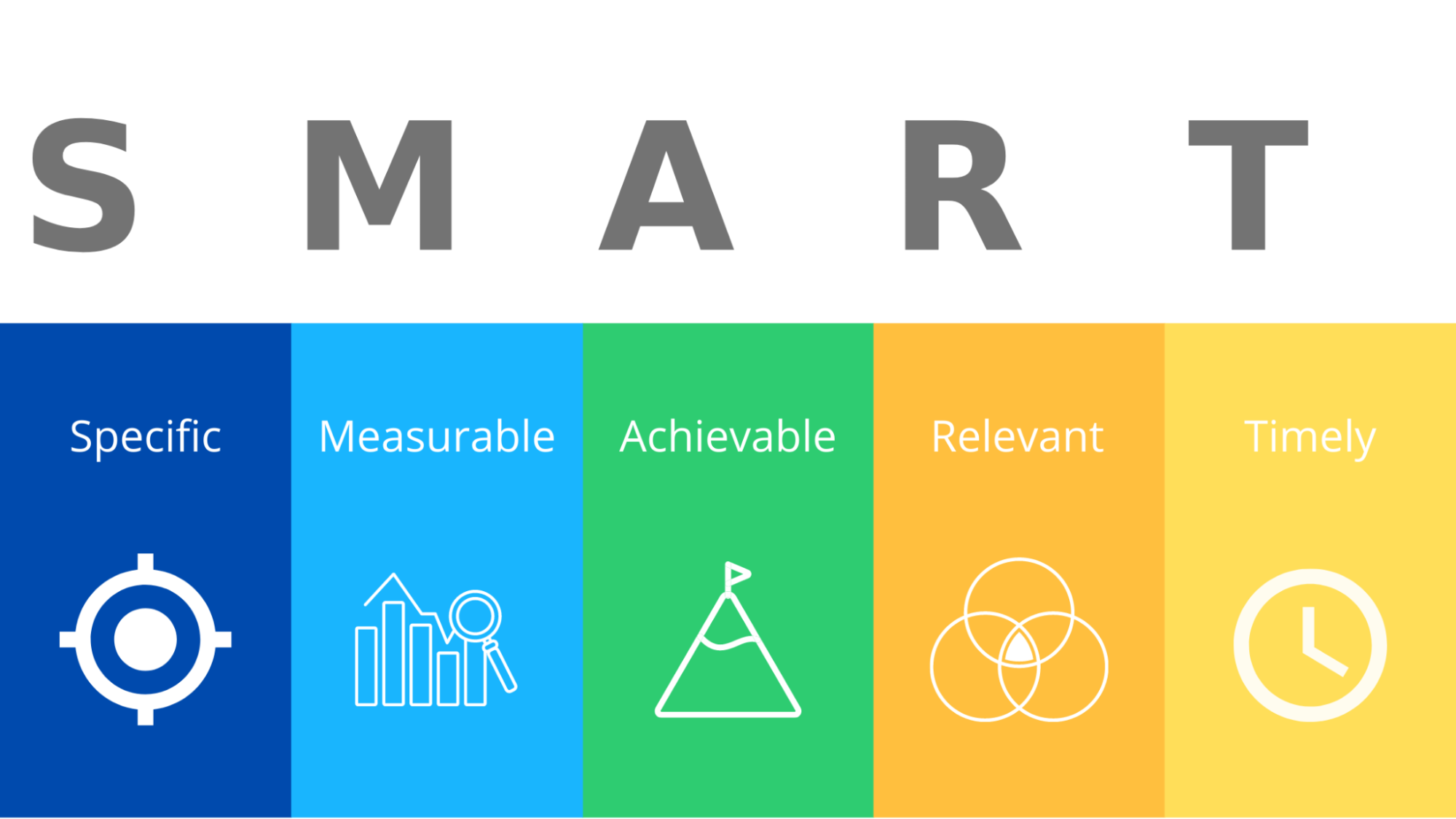The importance of setting goals, whether in business or life in general, cannot be exaggerated. Goals provide us with a sense of motivation and direction. However, setting goals is one thing; setting them correctly is a different ball game.
Falling short of your goals is normal, but if you are constantly unable to reach them, it could be because your goals are overambitious, vague, or unplanned. It’s easier to succeed when you have strategic goals that are clearly defined, attainable, and supported by a realistic plan for achieving them.
This is where the SMART goals template comes in. In this article, we will look at what SMART goals are, review the framework of this goal-setting template, and share a few tips and examples to assist you in your goal-setting efforts.
Supercharge your content reviews
Share, review, and approve all your content in one place with Filestage.
What are SMART goals?
In 1981, SMART methodology was first mentioned in George T. Doran’s article “There’s a SMART way to write management’s goals and objectives,” which was published in Management Review magazine. Doran discussed the complexity of defining and setting proper goals. This article marked the birth of SMART goals.
But what does SMART actually stand for?
Here’s a breakdown of the SMART acronym:
S – Specific
A goal should be precisely defined and shouldn’t be vague or ambiguous. Make it as precise as possible.
What questions should you answer?
Who needs to be involved in order to achieve this goal?
How can you encourage this person to collaborate?
What do you want to achieve? And how will you know that the objective has been achieved?
When do you want to accomplish your goal? What is the exact due date, and why?
Which capabilities are needed? And which challenges do you need to overcome?
Why should you achieve this goal?
Where do you want to accomplish your goal? (if applicable)
M – Measurable
Goals need to be measurable. Hence, you need to decide the metrics you want to use to measure your objectives.
What question should you answer?
How can you measure progress? And how do you know if you’ve successfully met your goal?
A – Achievable / Attainable
You should be able to complete your goal within the given time frame. Don’t neglect the encouraging effects of reaching a goal.
An objective can be ambitious, but keep in mind that failing to achieve your goal can damage your motivation. Hence, it makes sense to link it with your abilities and competencies.If you think that you can’t accomplish a certain goal, reflect on your missing skills.
What questions should you answer?
Are you capable of achieving this goal?
Do you have the needed skills? If not, how can you acquire them?
R – Relevant
A SMART goal should be relevant to and have a direct influence on your overall business goals. If there is no connection between them, consider reviewing the goal again. Chances are that it isn’t relevant enough, so you should aim for something else.
What questions should you answer?
Why should you achieve this goal?
What is the impact of achieving this goal?
How does the goal relate to your overall team and company goals?
T – Timely
It’s important to determine a deadline for each of your SMART goals. Additionally, you need to derive suitable tasks which will help you reach a certain goal. To determine the overall SMART goal deadline, you need to sum up the estimated time it will take to finish all of the derived tasks.
What questions should you answer?
What tasks need to be finished to achieve the goal?
How long does it take to finish these tasks?
When is the ultimate deadline for your goal?
Can the goal be achieved before this date?
Download a free SMART goals template
Fill out the form below to get instant access to our SMART goals template.
To save an editable copy, follow these simple steps:
- Click “File” in the top-left corner
- Click “Make a copy”
- Choose your destination folder
Why do you need SMART goals?
SMART goal setting puts you in the best position to achieve what you want in business and in life. This template offers a helpful way to use your time and resources productively by clarifying your ideas and focusing your efforts, ultimately increasing your chances of success. That said, below we share more detailed benefits of using the SMART goal-setting template.
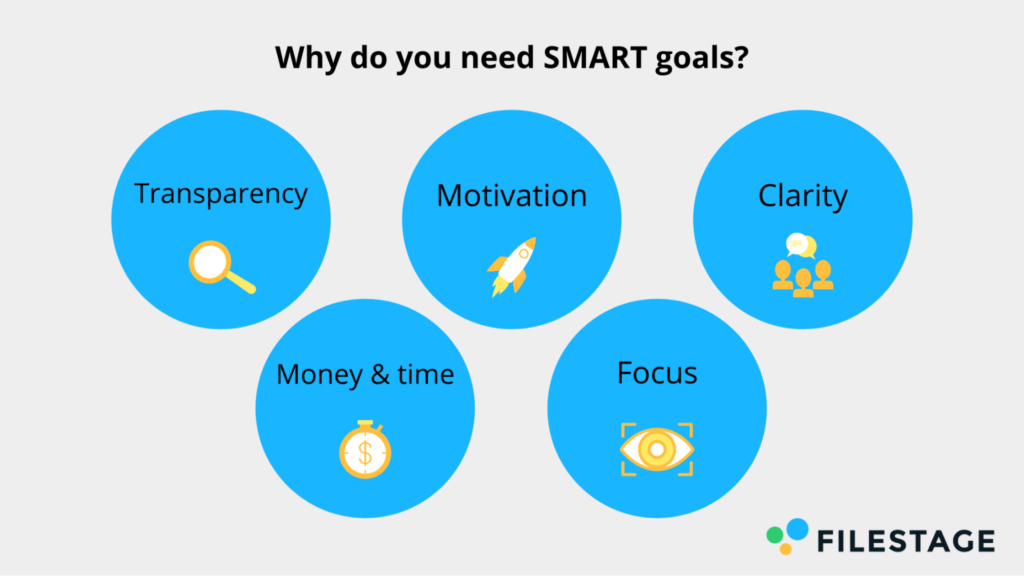
Transparency
SMART goals should be assigned to employees as they should know what you expect them to achieve. So, be transparent about your goals, and make them available to the whole team. That way, everyone can track the current progress and the potential hurdles.
Don’t use SMART goals as opportunities to paint individual team members in a bad light. Instead, establish an environment of trust. After all, failing is important. Missed goals can be incentives to develop new skills.
Motivation
SMART goals should be ambitious but still achievable and realistic. And even more importantly, they should be part of bigger team and company objectives. In fact, SMART goals are opportunities to break down your long-term goals.
It may sound hard to win 5,000 new customers in one year, but it sounds more achievable to send out ten emails per day. SMART goals can encourage your team to take action as well as celebrate successful projects more often.
Clarity
The classic example of a vague goal is “winning more clients.” It’s easy to tell your employees to canvas for customers. But what does canvassing actually mean?
If you ask ten employees, you’ll get ten different answers to that question. The reason is that the goal isn’t clear enough. You can make everyone’s lives easier by setting SMART goals since they’ll help your employees gain clarity.
Money and time
Missing a target can cost you a lot of time. Regularly reviewing your objectives will ensure that you’re on the right track and that your company isn’t wasting time and money.
Focus
When you’re working on a task, how do you know if you’re on the right track? Your SMART goal will tell you.
If you’re doing something that isn’t directly related to your objectives, stop doing it. Instead, concentrate on activities that are specifically tied to your goals. Using this method will help you and your team become super focused.
If you suspect that a SMART goal can’t provide you with this kind of direction, consider redefining the goal itself. The time spent laying the foundation will define your project’s trajectory.
Supercharge your content reviews
Share, review, and approve all your content in one place with Filestage.
How to write SMART goals
Writing a SMART goal is quite easy and straightforward. If you’re unsure of how to get started, or you need help improving your technique, this section will help you figure that out.
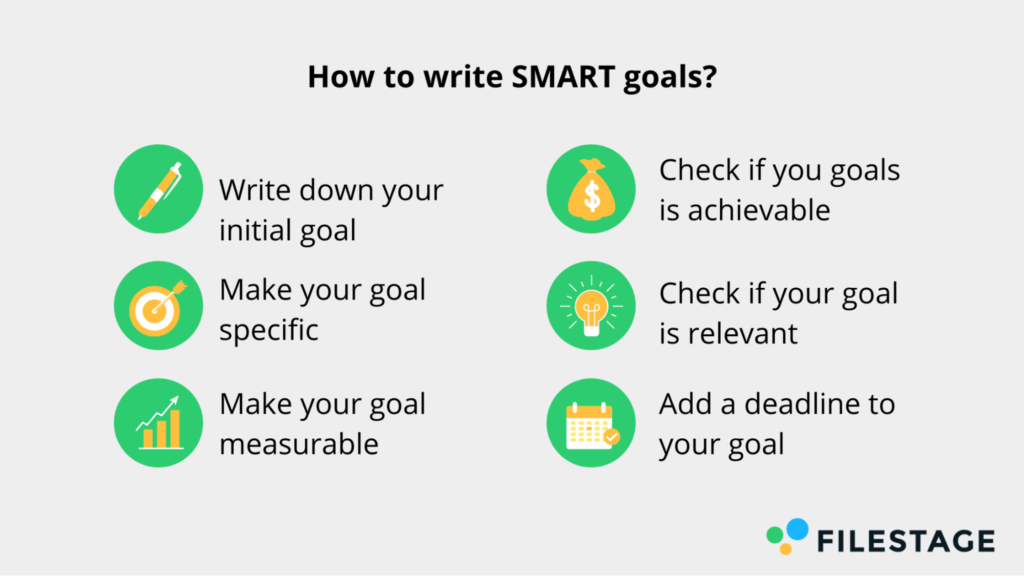
1. Write down your initial goal in one sentence
At this point, it’s okay if your draft goal lacks specifics, a timeline, and a course of action; it is just one sentence after all. An example of this would be “increase the number of customers”. The wording here is vague and basic, as expected. After this first step, you can proceed to use the SMART goals formula to clarify and improve your goal.
2. Make your goal specific
When writing SMART goals, always keep the target in mind. What exactly do you want to accomplish? Be as definitive as possible. Building on the example above, to add some specificity to our goal, we can say “to increase the number of customers as we establish ourselves as industry leaders in the market”.
3. Make your goal measurable
You should be able to track the progress of your goal. If not, how will you know when you’ve done enough work to be successful? A measurable SMART goal might read “to increase the number of customers by 10% per month”.
4. Check if your goal is achievable
There’s nothing wrong with dreaming big when setting goals. However, you’re setting yourself up for failure if your goals are too big and therefore unattainable. Ensure your set goals are realistic by taking into consideration your team’s ability to achieve them.
With the goal we have created so far, assuming our customers increased by 7% last month, our attainable SMART goal would be: “to increase the number of new customers by 10% every month”. This goal would, of course, be set after other factors like team size and budget are reassessed to ensure feasibility.
5. Check if your goal is relevant
A SMART goal is meant to be relevant to your company’s goals. You don’t want your team to lose sight and set goals that do not support the organization. For instance, assuming the goal of our business is to boost revenue, our SMART goal of increasing the number of customers by 10% will put the business on the right course to achieve this.
6. Add a deadline to your goal
Setting a target date for your goal applies a reasonable amount of pressure on your team to meet the deadline. Plus, a realistic timeline helps everyone prioritize tasks.
So, what does our SMART goal look like with a deadline? “By the end of this quarter, we will increase the number of customers by 10% per month”.
Tip: After you have developed your SMART goal, share it with important stakeholders to get their feedback and approval. The best way to do this is by using an online proofing tool like Filestage. Here, you can upload your file to a central platform where reviewers can leave clearer feedback in an easy and fast way.
Also, remember that setting goals is a process: First, you identify your goals, then you describe exactly what you want to achieve, and then you create an action plan with milestones that help ensure your project is a success.
SMART goals template
To help you properly define the right objectives, we prepared a SMART goals template. You can decide if you want to use it online (as a Google Doc) or download it (as a Word Doc). The advantage of using a Google Doc is that you can collaborate with multiple people in real-time.
SMART goals worksheet
Moreover, we also composed a SMART goals worksheet that will help you track goals. And we added some sample goals. Of course, feel free to adjust them according to your needs (and SMART goals).
We strongly advise that you start defining your objectives by using the SMART goals template. Afterward, you can use our duplicate our Google spreadsheet or download the worksheet as an Excel spreadsheet.
What are some examples of SMART goals?
You’re probably wondering, “What are three good SMART goals?”. Well, now that you know how to write and set SMART goals, let’s review some realistic examples of clear goals.
Example 1
A goal that’s not SMART: Win more leads.
Specific: We want to win more leads by increasing blog traffic, creating more webinars, and increasing the advertising budget for email marketing campaigns.
Measurable: We want to win 200 more leads per month.
Achievable: Our number of leads increased by an average of 150 since we started using this strategy three months ago, so aiming for 200 more leads every month should be attainable with increased budget and resources.
Relevant: By increasing the number of leads, we will drive more potential customers to our sales team, increase our customers and revenue.
Timely: In the next six months.
Final SMART goal description: In the next six months, we want to increase the number of leads by 1,200 by boosting our advertising budget for email marketing, growing blog traffic, and creating more content, all of which have proven to be the most effective strategies in acquiring new leads in the past.
Example 2
A goal that’s not SMART: Spend more time on self-development.
Specific: I want to improve my skill set by watching tutorials and enrolling in online courses on self-development in order to grow personally and professionally.
Measurable: My goal is to become proficient in public speaking, strategic and creative thinking, and problem-solving.
Achievable: I can set aside seven hours every week for my tutorials and online classes to learn the new skills I want to acquire.
Relevant: Improving my professional soft skills is essential to receiving a better performance review. A better performance review puts me in a good position to be considered for a promotion that could move my career forward.
Timely: In six months, I should develop skills in strategic thinking, public speaking and problem-solving.
Final SMART goal description: Free up one hour per day by more efficiently coordinating tasks and activities, and spend that hour on self-development activities to acquire skills that will keep me relevant in my job and industry.
Example 3
A goal that’s not SMART: Produce more content.
Specific: We want to produce more blog articles by hiring more writers and increasing our budget.
Measurable: We will post new blog articles five times every week.
Achievable: Currently, we publish three blog articles per week with three writers in place. By hiring two more writers, we will be able to publish five articles per week.
Relevant: Increasing our weekly publishing frequency will help boost our website’s organic traffic, increase our ranking in search engines, and improve brand awareness.
Timely: For the next twelve months.
Final SMART goal description: One year from now, we will have a 67% increase in blog content by increasing our weekly publishing frequency from 3 to 5 posts per week.
Tools that help you set up and achieve your SMART goals
It’s not enough to just define your SMART goals. You should have a tool that will help you track your progress as you start working towards achieving them. Below, we will review three examples of tools you can use to manage and report on your goals.
Goalscape
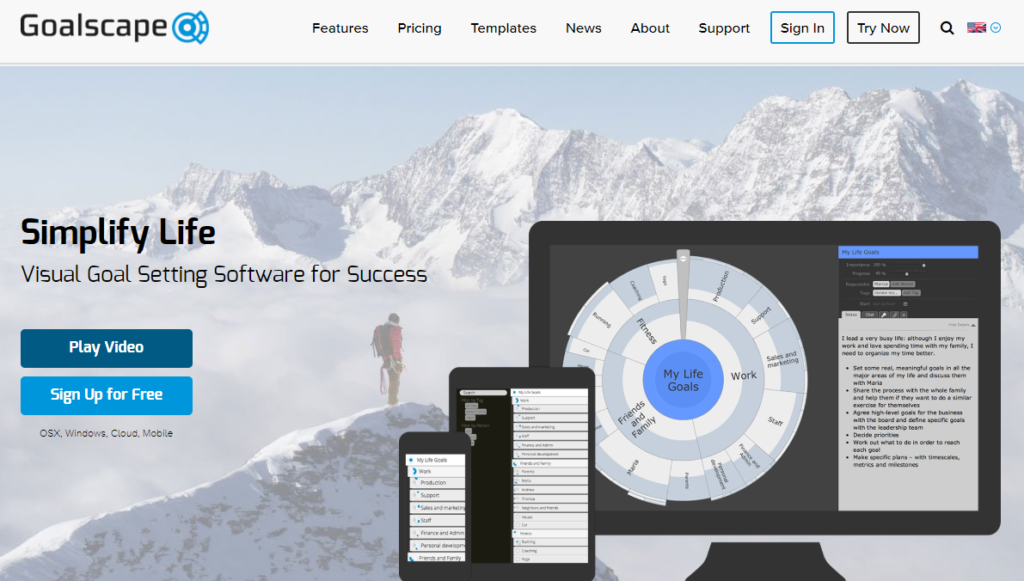
Goalscape is a goal-management app that visualizes your progress and provides you with informative charts about your activities. After you’ve defined your objectives, the app helps you stay on top of things and track your improvements.
Strides
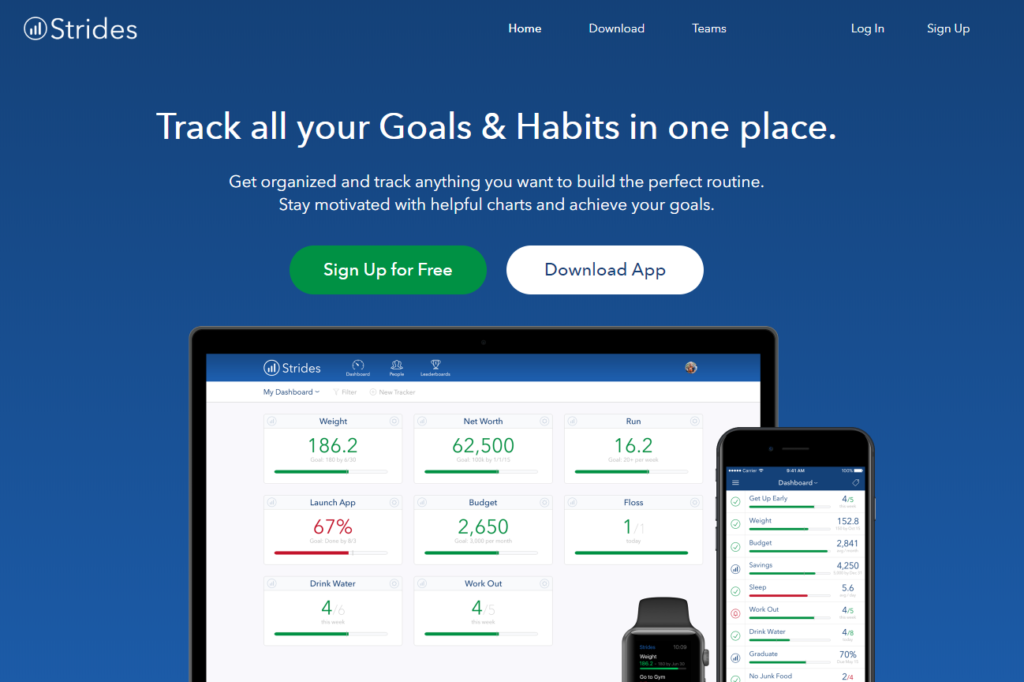
Strides helps you manage and track all of your goals and habits in one place. It motivates you by providing valuable progress charts. That way, you have a little helper that supports you while you’re achieving your goals.
Goals on Track

Goals on Track allows you to set and manage your goals. Moreover, it helps you create action plans to achieve your goals. With Goals on Track, you can efficiently manage your daily tasks and reach your goals step by step.
Conclusion
If you’re struggling to achieve your goals, try using the SMART goals approach. Often you will find that your objectives lack clarity or that they’re too vague. If that’s the case, you’ll never be able to achieve your desired outcome without changing the objectives themselves.
Feel free to use our SMART goals template to better define your objectives. This will help you to create clear and precise goals, so everybody knows what to work on in order to reach the team’s goal.



